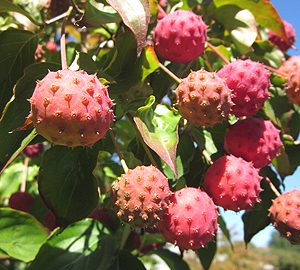
The days are getting shorter and cooler, and “sweater weather” has arrived. The Autumnal Equinox officially ushers in the new season and its promise of crisp air and show-stopping leaf displays. Fall is an especially busy time of the year and there’s much to do in the garden.
Our chives are producing a second bloom. And, some of our azaleas, clematis, roses, asters and dwarf lilacs are also in bloom. But the showstoppers are the red Kousa dogwood berries. It’s fun to watch the birds and bees enjoying them.
Alas, our hummingbirds have left, and we will be replacing their nectar holders with birdseed containers. Our Monarch butterflies have also gone, probably to The Monarch Butterfly Biosphere Reserve, a World Heritage site. The reserve is located in pine-oak forests, 62 miles northwest of Mexico City.
We are told that millions of butterflies arrive at the reserve annually. Butterflies inhabit a fraction of the reserve from October-March. The biosphere’s mission is to protect the butterfly species and its habitat. Most of the over-wintering Monarchs from eastern North America are found there. Western researchers discovered these areas in 1975.
We’re beginning to see advertisements for “Pick Your Own Pumpkins” and “Pick Your Own Apples” at local farms. Many “Harvest Festivals” are being planned. We’ve even seen some ads for turkey ice cream. Not for us, thank you!
In our vegetable garden, this year we had lots of zucchini blossoms but no zucchinis. A failure, for sure! Someone suggested hand pollination of the flowers, but who has the time to do that? I forgot to mention that rascally squirrels ate many of the zucchini seeds when they were first sown.
A “Big” thank-you is due to Renee Shepherd of Renee’s Garden Seed Company in Felton, California, for her kind offer of complimentary seeds to test in our garden. We’re still harvesting her ‘Emerite’ green pole filet beans, ‘Endeavor’ pickling cucumbers, ‘Sweetie Baby Romaine’ lettuce and ‘German Giant’ radishes.
Especially successful was the seed packet of fast-growing annual flowers that provided a feast for bees and other pollinators. At the base of the wooden fence bordering our vegetable garden, the colorful blossoms also added a very pretty focus point.
We’re approaching the end of Daylight Saving Time, but that’s still a while off. In the meantime, there’s much to do. Many of our perennials need dividing and re-planting, such as the sedums, daylilies, phlox, irises and ferns, to name a few.
I better get going!

